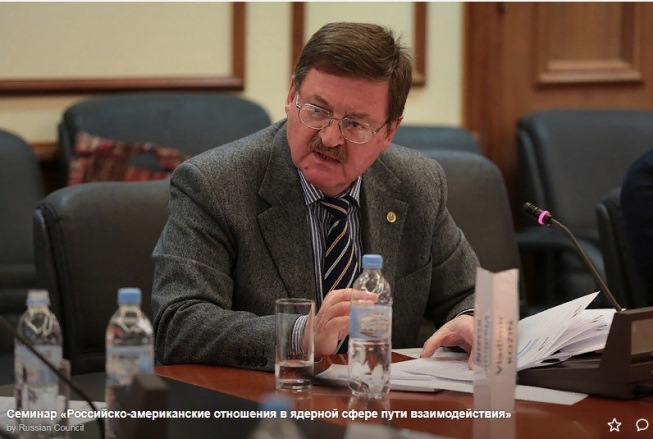
Vladimir P. Kozin's answers to five questions on the agenda of the seminar "Russian-American relations in the nuclear sphere: ways of interaction", formulated by its organizers.
The USA and Russia are facing the most dangerous security crisis in recent years for their nations and the world at large. The global implications of such crisis are also alarming. While the last century was labeled as the nuclear age, the current one has been characterized as ballistic missile defense age and as a potential space-based arms age.
The evident implications of such crisis have produced very strong negative impact, especially upon the arms control process.
In has nearly stalled. There are no any new talks in this domain. Such new talks are somewhere over the skyline.
There are 15 unresolved issues between the two nations in this area though during the first stage of the Cold War Washington and Moscow have managed to reach accords on strategic nuclear arms limitations and subsequently in their substantial reductions, on the ballistic missiles’ defense limitations, two classes of nuclear tipped medium-range and shorter-range land-based ballistic and cruise missiles have been scrapped, several confidences
I. To sign the legally-binding Treaty on no-first-use of any kind of nuclear weapons with any nuclear yield against each other. If such agreement is not formalized to reach agreements on the rest proposals listed below will be useless.
II. To arrive at an agreement on limiting the total number of strategic BMD interceptors to a certain limit, e.g. 2.000 for each side, excluding PAC-3 Patriot-type AAD/BMD for each side; and on limiting their geographic deployment closer than 1.000 km to each territory.
III. To forge an accord not to field for more than 24 hours any kind of nuclear weapons, both strategic and tactical, outside national territory of the two sides. The USA has to pull back all its tactical nuclear weapons from Europe and the Asian part of Turkey, thus making a geographic parity in their deployments limited to their respective territories.
IV. To formulate a bilateral treaty banning space-based striking weapons, including ASAT assets and BMDS interceptors.
V. To sign a new CFE Treaty applied to Europe covering the same five types of heavy weapons specified in the earlier CFE-1 and CFE-1A accords.
All these measures are the most urgent.
They require concrete solutions to be made at the level of the Presidents of the USA and the Russian Federation. Only they can, if they wish, to restore the profitable arms control process that has been implemented in the past. That is why the appeal should be addressed to them, to their wisdom and to their dedication to make our world safer, more stable and more predictable.
As to the specific five questions mentioned in the agenda of the current Roundtable discussion the shortest answers to them could be like this:
Q. On reduction of nuclear risks:
A.: The idea is fine, but it is unattainable, because of lack of mutual trust between Washington and Moscow and striking disparity between preconditions for using nuclear weapons – while the current U.S. NPR has 14 grounds to use them, the Russian nuclear doctrine has incorporated only two. The other stumbling block is a negative response of the USA towards 12 arms control arrangements with Russia.
Q. On avoidance of risks of using nuclear weapons due to accident or miscalculation:
A.: There is only one possible solution: to restore mutual trust, respect and confidence in practical manner – to sign a NFU (no-first-use) accord having unlimited duration between the USA and Russia. The USA has to pull back all its tactical nuclear weapons from 5 NATO-member states to the CONUS, and stop air patrolling near Russia involving heavy strategic bombers and ‘dual-capable aircraft’ in the Baltic Sea area.
As the ex-Defense Secretary William Perry has put it in his “My Journey at the Nuclear Brink” (2015) “… to make real progress in reducing nuclear dangers, the United States must lead” (P. 195). It is not serendipity that he used the phrase the USA “must lead”.
Q. On potential actions of the USA and Russia to stop or avoid a new arms race:
A.: For nuclear domain the answer is given in initial items of remarks given above: in number I and III; for conventional weapons the answer is given in item V; for outer space the answer is given in item IV, and for BMDS the answer is given in item II.
Q. On threat reduction on the Korean Peninsula:
A.: It is expedient for North and South Koreas to sign a NFU accord and the same treaty between the USA and North Korea; the USA has to offer to North Korea real security guarantees with a commitment not to attack it, not to change the regime, not to arrange a large-scale military drills near its shores, especially involving nuclear tipped SOA.
Q. On opportunities for future for scientific and technical collaboration between the USA and Russia:
A.: There will be no chances for such opportunities, except in the running the space station “Mir” and in the academic sphere exclusively dealing with arms control. It is impossible to foster any bilateral technical ties due to highly virulent sanctions’ decease that have been imposed arbitrarily upon more than 400 Russian enterprises and more than 200 high-ranking Russian individuals and businessmen. First of all, all these sanctions must be lifted off by the USA. Only after that Moscow will see what could be done in this and other areas of potential cooperation.



